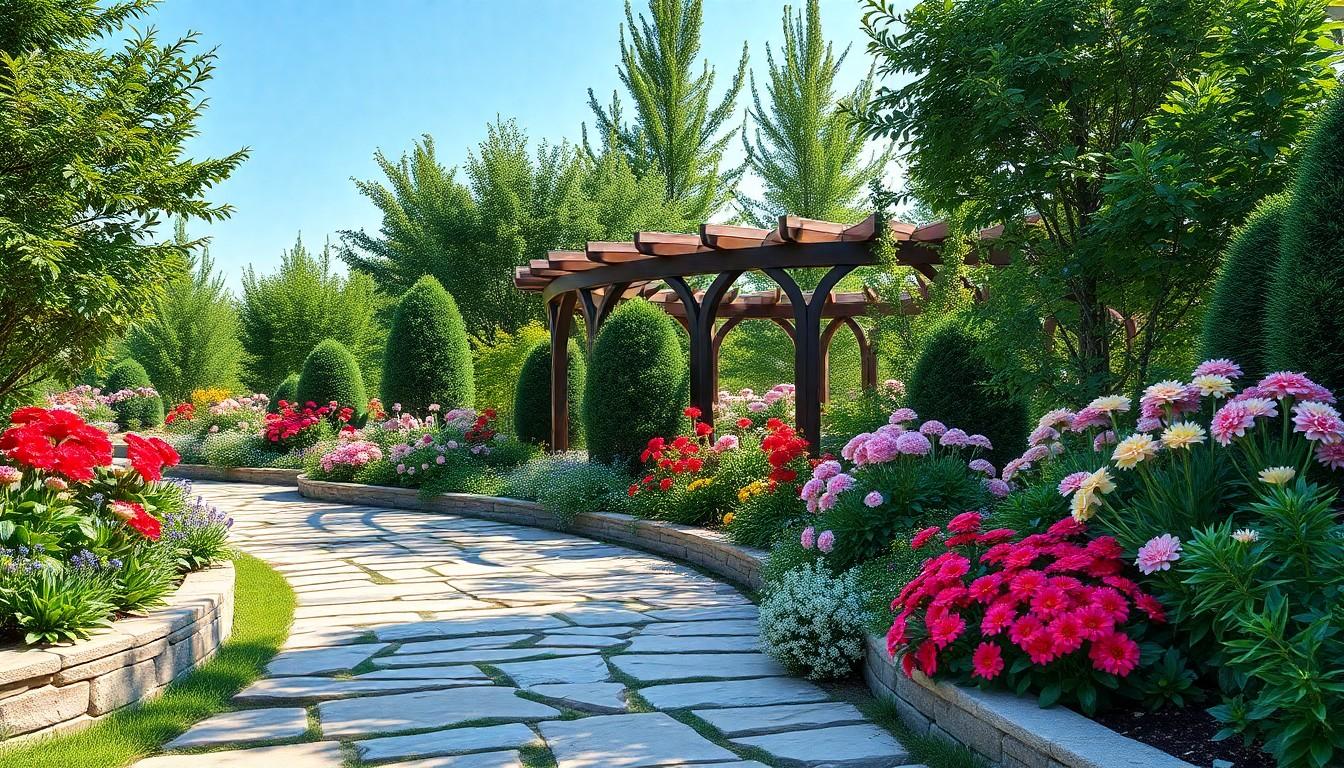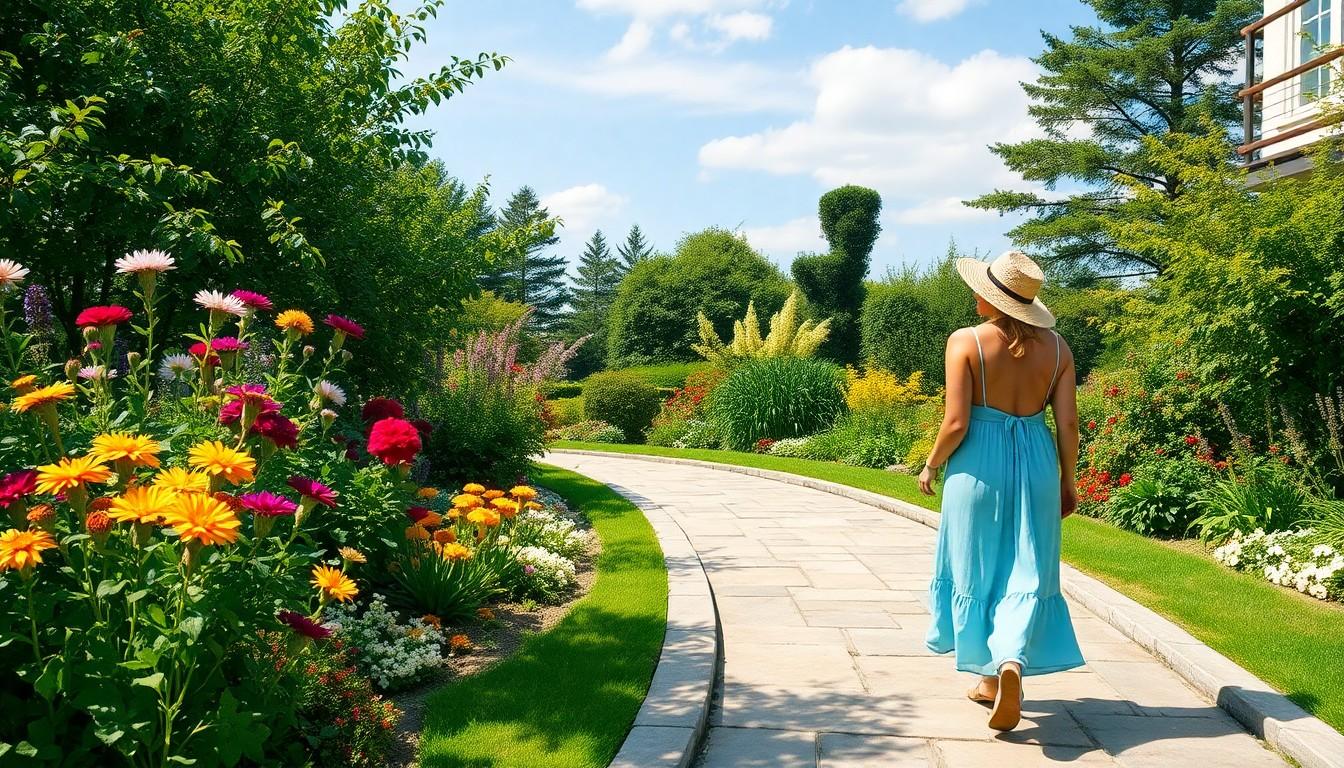A garden walkway isn’t just a path; it’s the red carpet of your outdoor oasis. Imagine stepping into a world where every stroll feels like a mini-vacation. With the right walkway, even a trip to fetch the garden hose can feel like a grand adventure.
Overview of Garden Walkways
A garden walkway serves as a functional and aesthetic element within outdoor spaces. This element guides visitors through gardens, allowing them to explore various plants, decorations, or seating areas. Different materials, such as stone, gravel, or brick, contribute to the overall design, enhancing the garden’s visual appeal.
Walkways provide practical benefits, including easy access for maintenance or leisure activities. They also define paths, preventing plant overgrowth while keeping soil intact. Strategically placed walkways can lead to focal points like sculptures or ponds, drawing attention and enhancing the garden’s atmosphere.
Incorporating curves and bends into walkway designs creates visual interest. Straight paths expedite movement but lack the charm of meandering routes. Gardeners can choose to integrate lighting along walkways, which adds safety and transforms the ambiance at night.
Wildlife benefits from walkways by encouraging natural exploration. Visitors can observe insects, birds, and small animals, making strolls enjoyable. The path layout can contribute to a sense of tranquility, turning a garden into a serene escape.
Creating walkways demands careful planning. One must consider the dimensions, surrounding plants, and overall landscape style. Each decision impacts both the functionality and aesthetics of the garden.
Weather-resistant materials and appropriate dimensions enhance walkways’ durability. Gardeners can ensure paths withstand the elements and remain attractive over time.
Addressing all these aspects leads to an inviting and captivating outdoor experience. One pathway invites strolls, while another subtly guides attention along the garden’s features. The combination of design, materials, and layout culminates in a thoughtfully curated garden walkway.
Types of Garden Walkways

Garden walkways come in various styles, each offering unique benefits and aesthetics. Understanding the different types helps in selecting the best option for a garden’s ambiance and functionality.
Paved Walkways
Paved walkways feature materials like concrete, bricks, or pavers. They provide durable surfaces that resist wear and weathering. Various colors and patterns enhance design flexibility. Maintenance remains straightforward; periodic cleaning keeps them looking pristine. These walkways ensure solid footing, particularly after rain, providing safety for visitors.
Gravel Walkways
Gravel walkways consist of loose stones, offering a casual look. They blend seamlessly into natural landscapes, supporting drainage. Different gravel sizes allow customization, affecting texture and comfort. Maintenance involves occasional raking and replenishing with gravel. Visitors might find the crunch underfoot pleasant, enhancing the sensory experience of the garden.
Wooden Walkways
Wooden walkways incorporate planks and boards, often created from treated lumber or composite materials. Their warmth and organic feel add charm to garden settings. Natural wood blends with surrounding plants, inviting a rustic ambience. Regular sealing maintains wood integrity, reducing weather-related damage. Walkways can also double as raised platforms, elevating the pathway above uneven ground.
Natural Stone Walkways
Natural stone walkways utilize materials like flagstone or slate, offering elegance and class. Each stone’s unique texture and color contribute to a personalized look. These walkways improve drainage due to their irregular surfaces. Installing them involves careful planning for stability and safety. Additionally, the durability of stone provides long-lasting beauty, enhancing garden appeal year-round.
Benefits of Installing a Garden Walkway
Garden walkways serve multiple benefits that enhance both functionality and enjoyment.
Aesthetic Appeal
Visual attractiveness defines a garden walkway’s charm. Unique designs complement existing landscape elements, providing a cohesive look. Textured materials, like natural stone or brick, create striking contrasts against lush greenery. Curved paths draw the eye, adding fluidity and movement. Colorful ground cover, like gravel or mulch, enhances the walkway’s presence. A well-placed walkway elevates the overall ambiance, making the garden feel inviting and well-maintained.
Improved Accessibility
Safe navigation defines the benefit of improved accessibility in garden walkways. Walkways provide even surfaces, reducing the risk of trips and falls, especially in uneven terrain. They offer clear paths to essential garden areas, like seating or plant beds. Those with mobility challenges find walkways essential for easy movement throughout the garden. By integrating wide spaces, walkers can easily accommodate wheelchairs and strollers. An accessible garden invites everyone to explore and enjoy its natural beauty.
Eco-Friendly Options
Sustainable materials contribute to eco-friendly walkways. Recycled bricks or permeable pavers support environmental stewardship while providing durability. Natural stone walkways promote drainage, minimizing water runoff and soil erosion. In contrast, gravel walkways enhance biodiversity, allowing rainwater to infiltrate the soil. Native plants alongside walkways can attract beneficial pollinators, enriching the landscape. Exploring these eco-conscious options supports a healthier garden ecosystem while offering practical advantages.
Designing Your Garden Walkway
A garden walkway combines aesthetics and functionality, guiding visitors while enhancing the space’s beauty. Thoughtful planning and design elevate an outdoor space significantly.
Planning the Layout
Effective layout planning starts with assessing the garden’s size and shape. Determining the most suitable route for the walkway helps create a logical flow. Curved pathways can introduce visual interest, while straight paths allow for efficient movement. Taking into account surrounding plant placements and existing features helps ensure harmony. Measuring dimensions accurately ensures comfort and accessibility, ultimately enhancing the experience for visitors.
Choosing Materials
Selecting the right materials impacts both durability and visual appeal. Concrete provides a sturdy surface, suitable for high traffic areas. Natural stone adds elegance and blends seamlessly with landscaping elements. Gravel pathways create a relaxed vibe and are easy to install, while wooden walkways introduce warmth and character. Prioritizing eco-friendly options, such as permeable pavers or reclaimed materials, supports sustainability and benefits the garden ecosystem.
Incorporating Landscaping Elements
Integrating landscaping elements enhances the overall design of the walkway. Strategically planting flowers or shrubs along the edges creates a lush, inviting atmosphere. Adding decorative features like sculptures or lighting highlights points of interest along the pathway. Garden benches can provide spots for relaxation and enjoyment. Ensuring these elements harmonize with the walkway contributes to a cohesive, beautiful garden design.
Maintenance Tips for Garden Walkways
Regular maintenance of garden walkways keeps them looking fresh and functional. Examine the surface for cracks or wear, addressing these issues promptly to prevent further damage. Clean walkways frequently to remove debris, dirt, and algae. Use a power washer, broom, or hose to keep surfaces free from buildup.
Consider sealing paved walkways every few years. Sealing enhances durability and protects against stains and weather impacts. Check gravel paths for displacement. Rake gravel back into place to maintain an even surface.
Weed control plays a vital role in upkeep. Apply mulch along the edges of walkways to deter weed growth. Inspect surrounding plants for overgrowth and trim as necessary to prevent encroachment.
Lighting components require regular attention. Replace burned-out bulbs immediately to ensure safety and visibility at night. During winter, handle snow and ice carefully. Clear walkways promptly after snowfall, using a shovel or snow blower.
Evaluate drainage systems periodically. Ensure that water drains away from walkways to prevent erosion or pooling. Utilize permeable materials for improved drainage and to reduce maintenance needs.
Perform seasonal assessments, addressing any issues that arise. Inspect for signs of settling or shifting materials, and adjust accordingly. Maintaining garden walkways not only enhances their appearance but also ensures safe and enjoyable navigation throughout the garden.
Conclusion
A garden walkway isn’t just a functional element; it’s a transformative feature that enhances the overall outdoor experience. By thoughtfully selecting materials and designs, garden walkways can create inviting paths that guide visitors through beautiful landscapes.
Incorporating curves and integrating lighting adds both charm and safety, while eco-friendly options support sustainable gardening practices. Regular maintenance ensures these pathways remain inviting and safe for everyone.
Ultimately, a well-planned walkway leads to exploration and enjoyment, making every visit to the garden a delightful journey.

